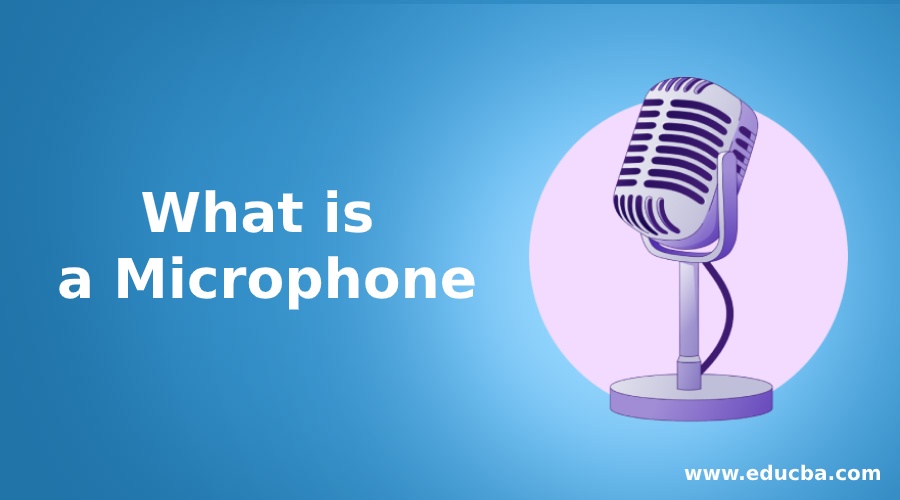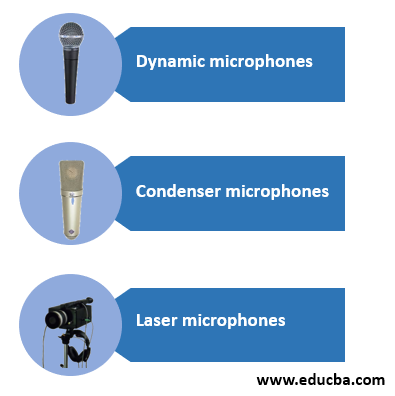Updated April 13, 2023

Introduction to Microphone
A Microphone is defined as a type of device that is used for the translation of sound vibrations into electric signals and converts them to some recording medium. The microphones are widely used in a different type of audio devices and also used for the communication purpose that includes speech recording and speech. The major purpose for designing of a microphone includes sound recorded. It is designed accordingly as per the use and can be categorized into many forms.
What is a Microphone?
It is defined as mechanical recreation for the human ears. The sound waves are travel in the air and go to ears. It is used the transduce and it can adjust in different directions. An omnidirectional sensitivity is equal at all the angles. It can be placed in a room and can have any direction and can transfer sound. In a bidirectional, the sound can be taken from the front or rear end. The sound cannot be taken from the side end. It is used in the place of speakers. This is compatible with the high-frequency sound.
Different Microphones
In below section some of the different microphones are described below:
1. Dynamic microphones
The dynamic microphones are a type of microphone that uses the diaphragms, coil, and magnets as components.
2. Condenser microphones
The condenser has a little bit different functionality as the diaphragm used for the movement of capacitor metal plates and then generates the electric current.
3. Laser microphones
The laser is a type of microphone that captures the vibrations from the surface and is able to capture sound from the distances. The lasers get to reflect back due to vibration and then the changes are further translated to sound waves.
This used for serving a special purpose. For e.g. if any news reporter is suing the microphone then they prefer to use the unidirectional microphones as they can take the sound from the only direction and eliminate the sound coming from all other directions.
How does the Microphone work?
The sound energy is traveled in the air. Until 19 century there was no device that can be used to sound to some other places. The microphones are designed for this purpose and used to convert sound signals into electric signals and can be used to transfer sound waves to longer distances.
In the below steps the working of it is described below:
- When the user speaks in it, the sound waves created by the user itself carry the energy to it. And the voice that is heard by the microphones is the vibration of energy present in the air and surroundings.
- The diaphragm is a type of component that is present in the microphones. It is very small in part and fixed inside of it. When the user speaks into it the diaphragm starts to move and move in back and forth direction because of sound waves.
- There is one coil also that is also directly connected to a diaphragm that also moves in back and forth direction just like a diaphragm.
- A small permanent magnet is also there is it that produces the magnetic fields which get cut because of the coil. And this coil that is connected to diaphragm starts to move in back and forth direction because of the magnetic field, hence an electric current starts to flow in the microphone.
- The current products in the microphone flow out of the device to the amplifier or some sound recording type device. And then the amplifier amplifies the user’s voice and can be transferred to a large set of audiences from that small device.
Advantages of Microphone
There is the various type that is basically designed for some special purpose and has its own advantages. Some of the advantages of the microphone are described below:
1. Voice command
The voice command is a type of microphone that is used by disabled people. The headset is used in which the distance between mouth and it remains constant but the movement becomes difficult because of wire. Handheld is used in giving a speech and the movement becomes easy as there is now wire but one hand of the user gets occupied.
2. Performance
The user uses it for giving speeches, stage shows, and also musical concerts. In all these situations the wireless is widely used because movement becomes easy with it. However, it has a range defined in which it works and also has limited battery life.
3. Mobiles
This is also used in it and it is inbuilt on mobile phones. The user can talk to another user because of it. And the microphones do not need to change extensively as it is in-built in mobile phones. The user can carry the mobile phone anywhere and can use it to listen to something.
4. Telex wireless
The telex wireless type is used in places where there is a requirement to address a large group of people. It is issued in news organizations and courtrooms where there is a need for addressing a large audience in a single time. This type of microphone has long battery life and is extremely secure.
History of Microphone
When there is a requirement of addressing a large set of audiences, it creates a need to raise a human voice. And for serving this purpose the megaphones were used. The first microphone was developed by David Edward Hughes and he was from England. The first microphone was a carbon-based. The carbon is the basic prototype of today’s microphones that are used extensively in different applications. In 1916, E.C. the condenser was developed. In 1923 the coil type microphone was built. Over the years and years, the microphones were been developed by many different organizations directionally.
Conclusion
It a type of device that used to amplify the voice and can be used in public-speaking and musical concerts. There is a different type of it that can be used in different scenarios as per the user requirements. The user speaks into it and hears the amplified version of his own voice using it.
Recommended Articles
This is a guide to What is a Microphone. Here we discuss an introduction to a Microphone, how does it work, advantages, and history. You can also go through our other related articles to learn more –


